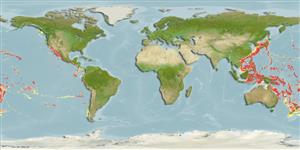Environment: milieu / climate zone / depth range / distribution range
Ecologie
marien bathydemersaal; diepte 100 - 1200 m (Ref. 559). Deep-water
Pacific Ocean: Philippines and Kyushu-Palau Ridge, near the Hawaiian Islands and the Sala y Gomez Ridge.
Grootte / Gewicht / Leeftijd
Maturity: Lm ? range ? - ? cm
Max length : 15.0 cm SL mannelijk / geslacht onbekend; (Ref. 559)
Korte beschrijving
Morfologie | Morfometrie
Dorsale stekels (totaal): 7; Dorsale zachte stralen (totaal): 10. Well-developed opercular spines present. Distance between anal opening and the beginning of the anal fin is 27-41 percent of the distance between the base of pelvic fin and the anal opening (Ref. 31632).
A mesobenthic-pelagic species living mainly above the bottom (Ref. 31632). Inhabits tops of seamounts (Ref. 559). Aggregations hovered over sand patches near steep, irregular cliffs (Ref. 7460).
Levenscyclus en paargedrag
Maturiteit | Voortplanting | Paaien | Eieren | Fecunditeit | Larven
Abramov, A.A., 1992. Species composition and distribution of Epigonus (Epigonidae) in the world ocean. J. Ichthyol. 32(5):94-108. (Ref. 31632)
Status op de Rode Lijst van het IUCN (Ref. 130435)
Gevaar voor de mens
Harmless
Gebruik door de mens
Meer informatie
Lokale namenSynoniemenMetabolismePredatorenEcotoxicologieVoortplantingMaturiteitPaaienPaaiaggregatiesFecunditeitEierenOntwikkeling van de eieren
Leeftijd/GrootteGroeiLengte-gewichtLengte-lengteLengtefrequentiesMorfometrieMorfologieLarvenLarvale populatiedynamiekRekruteringAbundantieBRUVS
ReferentiesAquacultuurAquacultuurprofielKweeklijnenGeneticaElectrophoresesErfelijkheidZiektesVerwerkingNutrientsMassaconversie
Tools
Speciale rapporten
Download XML
Internetbronnen
Estimates based on models
Preferred temperature (Ref.
123201): 5.8 - 16.8, mean 10.1 °C (based on 252 cells).
Fylogenetische diversiteitsindex (Ref.
82804): PD
50 = 0.5000 [Uniqueness, from 0.5 = low to 2.0 = high].
Bayesian length-weight: a=0.00646 (0.00278 - 0.01501), b=3.09 (2.88 - 3.30), in cm total length, based on LWR estimates for this (Sub)family-body shape (Ref.
93245).
Trofisch niveau (Ref.
69278): 3.5 ±0.5 se; based on size and trophs of closest relatives
Weerstandsvermogen (Ref.
120179): Gemiddeld, minimale populatieverdubbelingstijd 1,4-4,4 jaar (Assuming tm=2-4).
Fishing Vulnerability (Ref.
59153): Low vulnerability (10 of 100).
